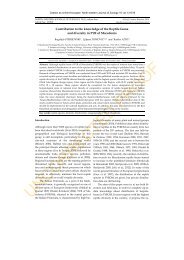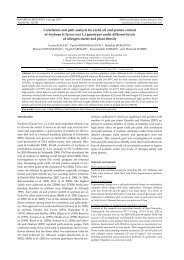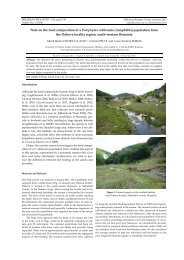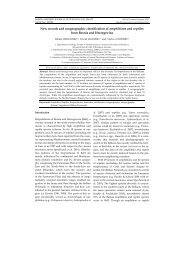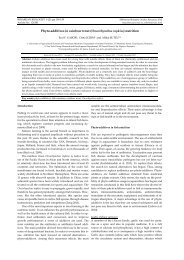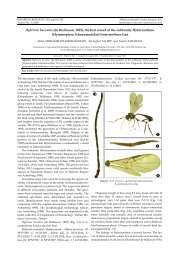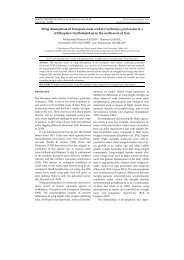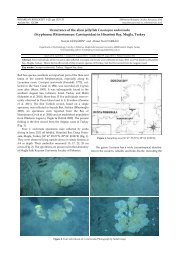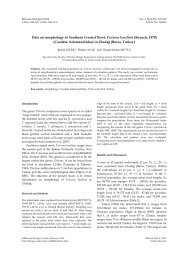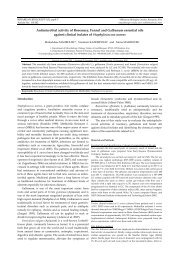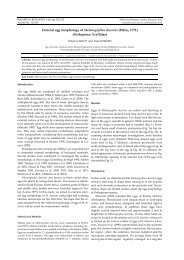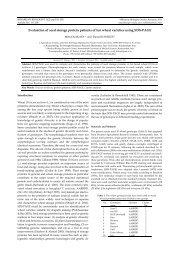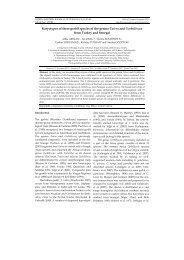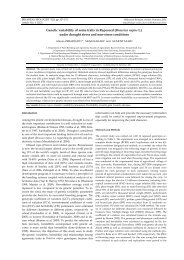Description of Dorcadion gashtarovi n.sp. (Coleoptera, Cerambycidae)
Description of Dorcadion gashtarovi n.sp. (Coleoptera, Cerambycidae)
Description of Dorcadion gashtarovi n.sp. (Coleoptera, Cerambycidae)
Create successful ePaper yourself
Turn your PDF publications into a flip-book with our unique Google optimized e-Paper software.
North-Western Journal <strong>of</strong> Zoology Vol. 6, No. 2, 2010, pp.286-293<br />
P-ISSN: 1584-9074, E-ISSN: 1843-5629 Article No.: 061128<br />
Introduction<br />
<strong>Description</strong> <strong>of</strong> <strong>Dorcadion</strong> <strong>gashtarovi</strong> n.<strong>sp</strong>.<br />
(<strong>Coleoptera</strong>, <strong>Cerambycidae</strong>)<br />
from Romania and Bulgaria<br />
with review <strong>of</strong> the closely related <strong>sp</strong>ecies<br />
Gianfranco SAMA 1, Maria-Magdalena DASCĂLU 2,* and Carlo PESARINI 3<br />
1. Via Raffaello 84, 47023 Cesena, Italy.<br />
2. «Al. I. Cuza» University, Faculty <strong>of</strong> Biology, Bd Carol I, 20A, 700506 Iaşi, Romania.<br />
3. Museo Civico di Storia Naturale, Corso Venezia, 55 I-20121 Milano, Italy.<br />
* Corre<strong>sp</strong>onding author, M.M. Dascălu; e-mail: dascalumm@yahoo.com<br />
Abstract – <strong>Dorcadion</strong> <strong>gashtarovi</strong> n.<strong>sp</strong>. from the historical region Dobruja (North-Eastern Bulgaria and<br />
South-Eastern Romania) is described. The new <strong>sp</strong>ecies belongs to the D. divisum <strong>sp</strong>ecies group. It is<br />
compared to three other similar <strong>sp</strong>ecies known to occur in Continental Europe (D. divisum dissimile,<br />
D. subinterruptum, D. granigerum) and a key is provided to separate them. <strong>Dorcadion</strong> subinterruptum is<br />
recorded for the first time in Europe.<br />
Key words: <strong>Cerambycidae</strong>, <strong>Dorcadion</strong>, Bulgaria, Romania, new <strong>sp</strong>ecies.<br />
<strong>Dorcadion</strong> Dalman, 1817 is a large genus which<br />
represents about 21% <strong>of</strong> the European cerambycid<br />
fauna, increasing to 40% if all <strong>sp</strong>ecies <strong>of</strong><br />
Iberodorcadion Breuning, 1943 (regarded by<br />
some authors as a <strong>Dorcadion</strong> subgenus) and all<br />
sub<strong>sp</strong>ecies are included (data derived from<br />
Danilevsky 2009). The highest number <strong>of</strong> <strong>sp</strong>ecies<br />
occurs in the Iberian Peninsula (Vives<br />
2000) and Greece (Pesarini & Sabbadini 2004),<br />
with <strong>sp</strong>ecies richness gradually decreasing to<br />
the north <strong>of</strong> these areas. Taking into consideration<br />
the high number <strong>of</strong> taxa with restricted<br />
geographical distribution, allopatric <strong>sp</strong>eciation<br />
seems to be very active in this group. The large<br />
intra<strong>sp</strong>ecific variability, the number <strong>of</strong> varieties<br />
described by previous workers and occasional<br />
inter<strong>sp</strong>ecific hybridization (Bahillo 1999, Dascălu<br />
2007) make the study <strong>of</strong> this group difficult<br />
and complex. Until recently, the only reference<br />
to the identification <strong>of</strong> this genus was<br />
the monograph <strong>of</strong> Breuning (1962); however<br />
the present paper contributes to a larger study<br />
on the revision <strong>of</strong> <strong>Dorcadion</strong> <strong>of</strong> Continental<br />
Greece (Pesarini & Sabbadini 2004, 2007, 2008,<br />
2010).<br />
<strong>Dorcadion</strong> <strong>gashtarovi</strong> n. <strong>sp</strong>. is described from<br />
an area which is relatively well studied and<br />
easily accessible to pr<strong>of</strong>essional and amateur<br />
entomologists, making the record more interesting.<br />
The present paper deals with this new<br />
<strong>sp</strong>ecies and three other very closely related<br />
European <strong>sp</strong>ecies.<br />
The first record that could be attributed to<br />
the new <strong>sp</strong>ecies (as <strong>Dorcadion</strong> divisum Germ. v.<br />
subinterruptum Pic) dates from the begining <strong>of</strong><br />
the 20 th century and belongs to Montandon<br />
(1908) who listed it from Mangalia (Romania).<br />
A few years ago Victor Gashtarov from<br />
S<strong>of</strong>ia sent G. Sama some <strong>sp</strong>ecimens <strong>of</strong> an unidentified<br />
<strong>sp</strong>ecies <strong>of</strong> the genus <strong>Dorcadion</strong> collected<br />
in North-Eastern Bulgaria. Around the<br />
same time, M. Danilevsky, studying the<br />
Tippmann collection, currently belonging to<br />
the National Museum <strong>of</strong> Natural History,<br />
©NwjZ, Oradea, Romania, 2010 North-West J Zool, 6, 2010<br />
www.herp-or.uv.ro/nwjz Oradea, Romania
<strong>Description</strong> <strong>of</strong> <strong>Dorcadion</strong> <strong>gashtarovi</strong> new <strong>sp</strong>ecies<br />
Smithsonian Institution, Washington (United<br />
States <strong>of</strong> America) (USNMNH), found one<br />
<strong>sp</strong>ecimen <strong>of</strong> the same taxon collected in Dobruja,<br />
Mangalia (Romania) by Montandon.<br />
Additional <strong>sp</strong>ecimens from Dobruja were studied<br />
by M. M. Dascălu, who also found a large<br />
series <strong>of</strong> <strong>sp</strong>ecimens collected mostly by N. Să-<br />
vulescu.<br />
The new <strong>sp</strong>ecies described hereunder is attributed<br />
to the subgenus Pedestredorcadion Breuning,<br />
1943, following Pesarini and Sabbadini<br />
(2010). This subgenus was synonymised with<br />
Cribridorcadion Pic, 1901 by Danilevsky et al.<br />
(2004) on the basis <strong>of</strong> the similar structures <strong>of</strong><br />
endophallus in the type <strong>sp</strong>ecies <strong>of</strong> both subgenera.<br />
While the former subgenus includes<br />
hundreds <strong>of</strong> quite heterogeneous taxa, the latter,<br />
based on the unique <strong>sp</strong>ecies D. mniszechi<br />
Kraatz, 1873, is very well characterized<br />
through the features briefly but exactly described<br />
by Pic (1901) in the original description<br />
and it has been always regarded as a mono<strong>sp</strong>ecific<br />
subgenus. A further distinctive feature<br />
Type material:<br />
Holotype ♂: ROMANIA. Mangalia lake, glade<br />
in Hagieni forest, 13.05.2005, leg. L. Fusu; Paratypes:<br />
ROMANIA. 1♂: Dobrudja, Mangalia,<br />
A.L. Montandon, “<strong>Dorcadion</strong> divisum Germ. /<br />
v. loratum”- “loan from USNMNH”; 2♂: Romania,<br />
Hagieni village, dry tributary <strong>of</strong> Mangalia<br />
lake, 11.05.2005, leg. L. Fusu; 1♀: Hagieni<br />
village, dry tributary <strong>of</strong> Mangalia lake,<br />
29.04.2006, leg. Dascălu M. M.; 1♀: Mangalia,<br />
glade in Hagieni Forest Natural Reserve<br />
27.V.2006 leg. Fusu; 1♀: Mangalia lake, glade in<br />
Hagieni forest, 14.05.2007 (dead under a stone)<br />
leg. Fusu L.; 1♀: Târguşor-Dobrogea, 12.V.2007<br />
(dead under a stone), leg. Fusu L.; 1♂: Târguşor-Dobrogea,<br />
12.V.2007, leg. Iorgu I.; 4♂: Dobrogea,<br />
Forest border to the S from Babadag<br />
village, 21.IV.2008, Leg. Iorgu I; 30 ♂, 14♀: Dobrogea,<br />
Forest border to the S from Babadag<br />
village, 14.V.2008, Leg. Fusu L.; 1♀: Târguşor –<br />
<strong>Dorcadion</strong> (Pedestredorcadion) <strong>gashtarovi</strong> n. <strong>sp</strong>.<br />
287<br />
<strong>of</strong> Cribridorcadion, mentioned by Breuning<br />
(1943) is the rounded tip <strong>of</strong> the median lobe <strong>of</strong><br />
aedeagus.<br />
The structure <strong>of</strong> the endophalus in Cribridorcadion<br />
sensu Pic and Pedestredorcadion is the<br />
most ancient within the tribe and similar to<br />
that <strong>of</strong> Morimus (see also Danilevsky et al.<br />
2004). Using Morimus as outgroup (for a photograph<br />
<strong>of</strong> the endophalus in this genus see<br />
Kasatkin, 2006) it is clear that endophalus<br />
structure <strong>of</strong> both Cribridorcadion sensu Pic and<br />
Pedestredorcadion is a plesiomorphic character<br />
state within the tribe and so, cannot be used to<br />
support monophyly <strong>of</strong> Cribridorcadion sensu<br />
Danilevsky, Kasatkin, & Rubenyan. As this is<br />
the only character used to synonymise the two<br />
subgenera, until a comprehensive phylogenetic<br />
analysis <strong>of</strong> the tribe, we prefer to consider Cribridorcadion<br />
and Pedestredorcadion as separate<br />
subgenera, the former including only D.<br />
mniszechi and the closely related taxa (<strong>sp</strong>ecies<br />
or well-differentiated sub<strong>sp</strong>ecies) semibrunneum<br />
Pic, 1903 and anamasum Pic, 1934.<br />
Dobrogea, 14.V.2008, Leg. Fusu L.; 8♂, 5♀: Dobrogea,<br />
Forest border to the S from Babadag<br />
village, 15.V.2009, Leg. Fusu L.; 3♂, 1♀: Hagieni<br />
Dobr. S., 19.V.1969, Dr. N. Săvulescu (nr.<br />
27460 - 27463); 3♂: Hagieni Dobr. S., 20.V.1969,<br />
Dr. N. Săvulescu (nr. 27464- 27466); 3♂:<br />
Hagieni Dobr. S., 21.V.1969 Dr. N. Săvulescu<br />
(nr. 27467- 27469); 1♂: Hagieni, 4.VI.1962, leg.<br />
Nicolae Săvulescu; 20♂, 25♀: Hagieni,<br />
29.V.1963, Dr. N. Săvulescu; 56♂, 28♀: Hagieni,<br />
29.VI.1963, leg. Nicolae Săvulescu; 1♂, 1♀:<br />
Hagieni, 6.VI.1964, leg. Nicolae Săvulescu; 1♂,<br />
1♀: Hagieni, 15.05.1968, leg. Aurelian Popescu-<br />
Gorj; 2♂, 2 ♀: Hagieni, 15.V.1978, leg. Nicolae<br />
Săvulescu; 1♂: Hagieni, 25.05.1982, leg. Albu; 9<br />
♂, 2♀: Hagieni, 6.05.1984, leg. Corneliu Pârvu;<br />
1♀: Babadag, 2.06.1958, leg. Cârdei; 4♂, 1♀: Babadag<br />
Codru, 25.V.1975 Dr. N. Săvulescu; 8♂,<br />
2♀: Albeşti, 29.IV.1991, leg. Nicolae Săvulescu;<br />
BULGARIA. 1♂: near Balchishkata Tuzla,<br />
North-West J Zool, 6, 2010
288<br />
08.V.2001, leg. Milen Marinov; 2♀: N. Black Sea<br />
coast, Kaliakra cape, 26.V.2005, leg. V. Gashtarov;<br />
1♂: N. Black Sea coast, before Kaliakra<br />
cape, 26/27.V.2005, leg. V. Gashtarov.<br />
Holotype in coll. Museo civico di Storia Naturale,<br />
Milano, (Italy); paratypes in USNMNH<br />
(Washington, USA), the N. Săvulescu collection<br />
(Natural Sciences Museum Complex <strong>of</strong><br />
Galaţi, Romania and “Grigore Antipa” National<br />
Museum <strong>of</strong> Natural History, Bucharest,<br />
Romania) and in the personal collections <strong>of</strong><br />
M.M. Dascălu (at Al. I. Cuza University <strong>of</strong> Iaşi,<br />
Romania), C. Pesarini (Milano, Italy), G. Sama<br />
(Cesena, Italy), V. Gashtarov (S<strong>of</strong>ia, Bulgaria),<br />
E. Migliaccio (Roma, Italy).<br />
<strong>Description</strong> <strong>of</strong> male:<br />
Body length: 11.5–13.8 mm; width: 4.2–5.3 mm.<br />
Head black with white <strong>sp</strong>arse pubescence<br />
and two elongated patches <strong>of</strong> black pubescence<br />
on vertex; antennae reddish brown, darkened<br />
towards apex; first antennal segment about<br />
1.2–1.5 times longer than third; first three antennal<br />
segments with dense white pubescence,<br />
the remainder covered with reddish pubescence.<br />
Pronotum quadrate to 1.1 times wider at<br />
base than long, with a median longitudinal<br />
white stripe bordered by two moderately wide<br />
black stripes, the sides are strongly punctate<br />
and largely covered with white, <strong>sp</strong>arse pubescence;<br />
lateral <strong>sp</strong>ines <strong>of</strong> pronotum conical, moderately<br />
short, acute and slightly curved upwards.<br />
Elytra about 1.9 times longer than wide,<br />
with weakly developed carinae and a shallow<br />
depression between the humeral and dorsal<br />
carinae, this depression weakly granulate near<br />
humeral callus, granules hidden by white<br />
clothing <strong>of</strong> humeral and dorsal stripes. Dorsum<br />
covered with dense, compact and dull black<br />
pubescence and longitudinal stripes <strong>of</strong> white<br />
pubescence: lateral stripe wide; humeral stripe<br />
wide, not interrupted or (in one <strong>sp</strong>ecimen) interrupted<br />
close to apical third <strong>of</strong> elytra; dorsal<br />
stripe well-developed, as wide as the interval<br />
North-West J Zool, 6, 2010<br />
Sama, G. et al.<br />
between the dorsal and humeral stripes or<br />
slightly narrower, pattern extremely variable:<br />
in some <strong>sp</strong>ecimens not interrupted, with few<br />
dark <strong>sp</strong>ots, usually clearly interrupted at beginning<br />
<strong>of</strong> its apical third and/or behind its<br />
proximal third, usually does not reach the apex<br />
<strong>of</strong> elytra and is not fused with humeral stripe<br />
but occasionally (in one <strong>sp</strong>ecimen) partially<br />
fused with the humeral stripe at the elytral<br />
apex; presutural stripe present as a short,<br />
slightly oblique basal stroke which may be interrupted<br />
by black pubescence or prolonged<br />
with small white <strong>sp</strong>ots; sutural stripe white<br />
and narrow (Fig. 2a, b, 3d).<br />
Underside black, with white pubescence;<br />
legs reddish brown with darker tarsi and covered<br />
with white pubescence.<br />
Median lobe <strong>of</strong> aedeagus relatively slender;<br />
its apical constriction subsinuate at sides (Fig.<br />
4.1a). Parameres rather short, less than twice as<br />
long as broad, broadly rounded at tip, with<br />
short setae only on their apical third (Fig. 4.1b).<br />
<strong>Description</strong> <strong>of</strong> female:<br />
Body length: 12.2–14.5 mm; width: 4.6–5.5 mm.<br />
The females always androchromatic and<br />
differ from males by characters linked with<br />
sexual dimorphism. Antennae slightly surpassing<br />
elytral half (in males reaching apical<br />
fourth), and first antennal segment 1.5 times<br />
longer than third. Pronotum more transverse,<br />
1.2 times wider at base than long, with lateral<br />
<strong>sp</strong>ines slightly longer than in male. Elytra<br />
ovoid, less elongate than male, 1.7–1.8 times as<br />
long as wide with slightly better developed<br />
carinae; shallow depression between humeral<br />
and dorsal carinae wider. Humeral white<br />
stripe usually not interrupted, but in few<br />
<strong>sp</strong>ecimens partly or entirely obliquely interrupted<br />
or just abruptly narrowed after anterior<br />
third <strong>of</strong> elytra (Fig. 2c, 3e).<br />
Etymology: D. <strong>gashtarovi</strong> n. <strong>sp</strong>. is dedicated to<br />
our friend and colleague Victor Gashtarov<br />
(S<strong>of</strong>ia, Bulgaria) who firstly paid attention to<br />
the new <strong>sp</strong>ecies.
<strong>Description</strong> <strong>of</strong> <strong>Dorcadion</strong> <strong>gashtarovi</strong> new <strong>sp</strong>ecies<br />
Distribution: <strong>Dorcadion</strong> <strong>gashtarovi</strong> has been collected<br />
from six localities in Romania and Bulgaria<br />
along the coast <strong>of</strong> the Black Sea, in the<br />
historic region <strong>of</strong> Dobruja (Fig. 1).<br />
Figure 1. Localities <strong>of</strong> <strong>Dorcadion</strong> <strong>gashtarovi</strong> n. <strong>sp</strong>.:<br />
1.) Hagieni and Albeşti; 2.) Mangalia; 3.) Târguşor-Dobrogea;<br />
4.) Babadag; 5.) Kaliakra cape;<br />
6.) Balchishkata Tuzla.<br />
Figure 2. <strong>Dorcadion</strong> <strong>gashtarovi</strong> n. <strong>sp</strong>.: a.) ♂ habitus; b.) variability <strong>of</strong> elytral pattern in males;<br />
c.) variability <strong>of</strong> elytral pattern in females.<br />
Comparison with related <strong>sp</strong>ecies<br />
<strong>Dorcadion</strong> <strong>gashtarovi</strong> is well distinguished from<br />
D. divisum Germar, 1839 s. lat. and other <strong>sp</strong>ecies<br />
<strong>of</strong> D. divisum <strong>sp</strong>ecies- group (sensu Pesarini<br />
& Sabbadini, 2008) occurring in Continental<br />
Europe by the weakly developed ra<strong>sp</strong>-like<br />
289<br />
granulation on the base <strong>of</strong> the elytrae and the<br />
considerably shorter and stouter parameres.<br />
The different shape <strong>of</strong> median lobe <strong>of</strong> aedeagus<br />
also separates the new <strong>sp</strong>ecies from the currently<br />
ill-defined Anatolian forms <strong>of</strong> D. divisum<br />
s. lat., the precise systematic definition <strong>of</strong><br />
North-West J Zool, 6, 2010
290<br />
which is beyond the scope <strong>of</strong> this paper and<br />
requires further study. The new <strong>sp</strong>ecies is able<br />
to be distinguished from D. divisum dissimile<br />
Ganglbauer, 1884 which occurs in European<br />
Turkey (Kadlec 2006) by the reduction <strong>of</strong> the<br />
presutural stripe, this stripe being limited at<br />
most to the anterior third <strong>of</strong> elytra, instead <strong>of</strong><br />
being nearly complete (but not always, as written<br />
by Kadlec 2006); and by having shorter antennae<br />
that in D. <strong>gashtarovi</strong> reach the apical<br />
fourth <strong>of</strong> the elytra in males and slightly beyond<br />
half in females, while in D. divisum dissimile<br />
they reach the apical fifth <strong>of</strong> the elytra in<br />
males and the apical two-fifths in females. The<br />
new <strong>sp</strong>ecies can be distinguished from the<br />
Greek <strong>sp</strong>ecies D. granigerum Ganglbauer, 1884<br />
(which has sometimes a similar elytral pattern)<br />
by the more developed humeral callus <strong>of</strong> elytra<br />
and the quite different shape <strong>of</strong> male genitalia<br />
(see also Pesarini & Sabbadini 2007, Fig. 36).<br />
To the list <strong>of</strong> <strong>sp</strong>ecies currently known from<br />
Continental Europe, we add here D. subinterruptum<br />
Pic, 1900 <strong>of</strong> which we examined a small<br />
North-West J Zool, 6, 2010<br />
Sama, G. et al.<br />
series <strong>of</strong> <strong>sp</strong>ecimens found near Enez (European<br />
Turkey, province <strong>of</strong> Edirne, 02.V.2008, leg.<br />
Pesarini & Sabbadini). This <strong>sp</strong>ecies is easily<br />
distinguishable from all other European members<br />
<strong>of</strong> the D. divisum <strong>sp</strong>ecies group by its entirely<br />
black legs and having the dorsal band <strong>of</strong><br />
elytra always broken into three or four wellseparated<br />
stretches. The old record <strong>of</strong> this <strong>sp</strong>ecies<br />
by Montandon (1908) from Mangalia, Romania<br />
(as <strong>Dorcadion</strong> divisum Germ. v. subinterruptum<br />
Pic), was clearly based on <strong>sp</strong>ecimens <strong>of</strong><br />
D. <strong>gashtarovi</strong> since this is the only <strong>sp</strong>ecies <strong>of</strong> the<br />
group occurring near Mangalia.<br />
Another erroneous record connected with<br />
D. <strong>gashtarovi</strong> is that <strong>of</strong> Balaci (2000) who published<br />
D. septemlineatum Waltl, 1838 from Romania<br />
on the basis <strong>of</strong> ten <strong>sp</strong>ecimens collected<br />
by N. Săvulescu on 29.V.1963 at Hagieni. We<br />
have not seen these <strong>sp</strong>ecimens but all material<br />
from Hagieni collected and identified provisionally<br />
by N. Săvulescu as D. septemlineatum<br />
belongs to D. <strong>gashtarovi</strong> (see under type material).<br />
These apparently similar <strong>sp</strong>ecies can be separated by the following key:<br />
1. Elytral base with weak ra<strong>sp</strong>-like granulation, granules hidden by white clothing <strong>of</strong> humeral<br />
and dorsal stripes. Parameres short and stout, broadly rounded apically and with setae covering<br />
less than the apical half; median lobe <strong>of</strong> aedeagus with a moderately elongate apex and a<br />
moderately developed opercular dorsal portion (Fig. 4.1a,b). Bulgaria, Romania………………<br />
…………………………..…………………………….. …….........................................<strong>gashtarovi</strong> n. <strong>sp</strong>.<br />
-. Elytral base with strong ra<strong>sp</strong>-like granulation, granules well visible among white clothing <strong>of</strong><br />
humeral and dorsal stripes. Parameres at least moderately elongate, slender; median lobe <strong>of</strong><br />
aedeagus sometimes different ……….................................................................................................2<br />
2. Legs entirely black. White dorsal band <strong>of</strong> elytra broken into three or more well separated<br />
stretches (Fig. 3a). Parameres elongate, slender, apex narrowly rounded and with setae covering<br />
less than the apical half; median lobe <strong>of</strong> aedeagus with a moderately elongate apex and<br />
with a moderately developed opercular dorsal portion (Fig. 4.2a,b). European and North-<br />
Western Asiatic Turkey............................................................................................subinterruptum Pic<br />
-. Legs largely reddish. White dorsal band <strong>of</strong> elytra different. Parameres and median lobe <strong>of</strong><br />
aedeagus different ……............................................................................................................................3<br />
3- Elytra with receding humeri (Fig. 3c). Parameres elongate, slender, apex narrowly rounded<br />
and with setae covering more than the apical half; median lobe <strong>of</strong> aedeagus with a stout apex<br />
and with a narrow opercular dorsal portion (Fig.4.3a,b). Continental Greece……………<br />
……………………………………………………………………………….....granigerum Ganglbauer
<strong>Description</strong> <strong>of</strong> <strong>Dorcadion</strong> <strong>gashtarovi</strong> new <strong>sp</strong>ecies<br />
-. Elytra with well-marked humeri (Fig.3b). Parameres moderately elongate, apex broadly<br />
rounded and with setae covering less than the apical half; median lobe <strong>of</strong> aedeagus with a<br />
moderately elongate apex and with a broad opercular dorsal portion (Fig. 4.4a,b). European<br />
Turkey……………………………………………………..……….......divisum dissimile Ganglbauer<br />
Figure 3. Habitus photographs <strong>of</strong>: a) D. subinterruptum, ♂ from 2 km W Enez, vil. Edirne, European Turkey;<br />
b) D. divisum s<strong>sp</strong>. dissimile, ♂ from 15 km SW Gelibolu, vil. Edirne, European Turkey; c) D. granigerum, ♂<br />
from 4 Km S Erithres, nom. Attiki, Greece; d) ♂, e) ♀ D. <strong>gashtarovi</strong> n. <strong>sp</strong>., paratypes from Mangalia Lake,<br />
Romania.<br />
291<br />
North-West J Zool, 6, 2010
292<br />
Fig. 4. Male genitalia <strong>of</strong> the European <strong>sp</strong>ecies in the D. divisum group: (a. apex <strong>of</strong> median lobe <strong>of</strong><br />
aedeagus; b. parameres). 1) <strong>Dorcadion</strong> <strong>gashtarovi</strong> n. <strong>sp</strong>., holotype ♂ from Mangalia Lake, Romania;<br />
2) D. subinterruptum, ♂ from 2 km W Enez, vil. Edirne, European Turkey; 3) D. granigerum,<br />
♂ from 4 Km S Erithres, nom. Attiki, Greece; 4) D. divisum dissimile, ♂ from 15 km SW Gelibolu,<br />
vil. Edirne, European Turkey.<br />
Acknowledgements. We acknowledge with gratitude the<br />
following people who contributed to this paper: Ms<br />
Rodica Serafim (Grigore Antipa National Museum <strong>of</strong><br />
Natural History, Bucharest) and Ms Dr. Gabriela Patriche<br />
(Natural Sciences Museum Complex, Galaţi) for the loan<br />
<strong>of</strong> <strong>sp</strong>ecimens and allowing one <strong>of</strong> us (M. M. Dascălu) to<br />
study the collections under their care. Dr. M.L.<br />
Danilevsky (A.N. Severtsov Institute <strong>of</strong> Ecology and Evolution,<br />
Moscow) is acknowledged for the loan <strong>of</strong> the<br />
paratype <strong>of</strong> USNMNH and Mr. E. Migliaccio (Roma, Italy)<br />
for sending <strong>sp</strong>ecimens for study. Many thanks to Dr.<br />
L. Fusu and Dr. I. Iorgu for their help during collecting<br />
trips; L. Fusu is further acknowledged for the habitus<br />
drawing <strong>of</strong> the new <strong>sp</strong>ecies and Dr. I. E. Popescu for his<br />
support in the earlier stage <strong>of</strong> the study. This work was<br />
partly sustained by a fellowship accorded to M.M. Dascălu<br />
through the post-doctoral programme POS-<br />
DRU/89/1.5/S/49944 “Developing the innovation capacity<br />
and improving the impact <strong>of</strong> research through<br />
post-doctoral programmes”.<br />
North-West J Zool, 6, 2010<br />
References<br />
Sama, G. et al.<br />
Bahillo de la Puebla, P. (1999): Un posible hibrido intersubgenerico<br />
entre Iberodorcadion (s. str.) <strong>sp</strong>inolae s<strong>sp</strong>. caunense<br />
(Lauffer, 1910) e Iberodorcadion (Hi<strong>sp</strong>anodorcadion) ru<strong>sp</strong>olii<br />
(Breuning, 1975) (<strong>Coleoptera</strong>, <strong>Cerambycidae</strong>). Biocosme<br />
Mésogéen, Nice 15 (1): 273–284.<br />
Balaci, A. (2000): Catalogul familiei <strong>Cerambycidae</strong> (<strong>Coleoptera</strong>)<br />
din colectia Muzeului Banatului Timişoara. Analele<br />
Banatului, seria Stiinţele Naturii 5: 153–185. [in Romanian]<br />
Breuning, S. (1943): Beitrag zur Wertung der Genschlenchtsorgane<br />
für die Systematik. Zeitschrift für Morphologie<br />
und Ökologie der Tiere 39: 523–526.<br />
Breuning, S. (1962): Revision der <strong>Dorcadion</strong>ini (<strong>Coleoptera</strong><br />
<strong>Cerambycidae</strong>). Entomologische Abhandlungen und<br />
Berichte aus dem Staatlichen Museum für Tierkunde in<br />
Dresden 27: 1–665.<br />
Danilevsky, M.L., Kasatkin, D.G., Rubenyan, A.A. (2004): Revision<br />
<strong>of</strong> the taxonomic structure <strong>of</strong> the tribe <strong>Dorcadion</strong>ini<br />
(<strong>Coleoptera</strong>, <strong>Cerambycidae</strong>) on the base <strong>of</strong> the<br />
endophallic morphology. Russian Entomological Journal<br />
13(3): 127–149.<br />
Danilevsky, M.L. (2009): <strong>Cerambycidae</strong> <strong>of</strong> Europe. http://<br />
www.cerambycidae.net/, [accessed at 20.07.2009].
<strong>Description</strong> <strong>of</strong> <strong>Dorcadion</strong> <strong>gashtarovi</strong> new <strong>sp</strong>ecies<br />
Dascălu, M.M. (2007): An inter<strong>sp</strong>ecific hybrid between <strong>Dorcadion</strong><br />
holosericeum Krynicky, 1832 and <strong>Dorcadion</strong><br />
tauricum Waltl, 1838 (Insecta, <strong>Coleoptera</strong>, <strong>Cerambycidae</strong>).<br />
Biocosme Mésogéen, Nice 24(2): 65–72.<br />
Ganglbauer, L. (1884): Bestimmungstabellen der europäischen<br />
Coleopteren. VIII. <strong>Cerambycidae</strong>. Verhandlungen<br />
der k. k. zoologisch-botanischen Gesellschaft in Wien<br />
33[1883]: 437–586.<br />
Kadlec, S. (2006): Two new <strong>sp</strong>ecies <strong>of</strong> the genus <strong>Dorcadion</strong><br />
Dalman, 1817 from Iran and Turkey (<strong>Coleoptera</strong>:<br />
<strong>Cerambycidae</strong>: Lamiinae). Animma.X 12: 8–15.<br />
Kasatkin, D.G. (2006): The internal sac <strong>of</strong> aedeagus <strong>of</strong> longhorned<br />
beetles (<strong>Coleoptera</strong>: <strong>Cerambycidae</strong>): morphology,<br />
nomenclature <strong>of</strong> structures, taxonomic significance.<br />
Caucasian Entomological Bulletin 2(1): 83–104.<br />
Montandon, A.L. (1908): Notes sur la faune entomologique de<br />
la Roumanie- additions au catalogue des coléoptères.<br />
Bulletin de la Société des Sciences de Bucarest-Roumanie<br />
17(1–2): 67–118.<br />
Pesarini, C., Sabbadini, A. (2004): Ricerche sui Dorcadiini di<br />
Grecia. I. Le <strong>sp</strong>ecie del Peloponneso (<strong>Coleoptera</strong> <strong>Cerambycidae</strong>).<br />
Atti della Societa Italiana di Scienze Naturali e<br />
del Museo Civico di Storia Naturale in Milano, Giugno<br />
145(1): 133–153.<br />
Pesarini, C., Sabbadini, A. (2007): Ricerche sui Dorcadiini di<br />
Grecia. II. Le <strong>sp</strong>ecie della Grecia centromeridionale e<br />
quelle del gruppo di <strong>Dorcadion</strong> kozanii (<strong>Coleoptera</strong><br />
<strong>Cerambycidae</strong>). Atti della Societa Italiana di Scienze<br />
293<br />
Naturali e del Museo Civico di Storia Naturale in Milano<br />
148(1): 35–83.<br />
Pesarini, C., Sabbadini, A., (2008): Ricerche sui Dorcadiini di<br />
Grecia. III. Le <strong>sp</strong>ecie di Neodorcadion Ganglbauer, 1884,<br />
quelle del gruppo di <strong>Dorcadion</strong> ljubetense e descrizione<br />
della nuova <strong>sp</strong>ecie <strong>Dorcadion</strong> ariannae (<strong>Coleoptera</strong><br />
<strong>Cerambycidae</strong>). Atti della Societa Italiana di Scienze<br />
Naturali e del Museo Civico di Storia Naturale in Milano<br />
149(1): 109–124.<br />
Pesarini, C., Sabbadini, A. (2010): Ricerche sui <strong>Dorcadion</strong>ini<br />
di Grecia. IV. Le <strong>sp</strong>ecie della Macedonia e della Tracia<br />
(<strong>Coleoptera</strong> <strong>Cerambycidae</strong>). Atti della Societa Italiana di<br />
Scienze Naturali e del Museo Civico di Storia Naturale in<br />
Milano 151(2):179-216.<br />
Pic, M. (1901): <strong>Description</strong>s. Matériaux pour servir a l`etude<br />
des Longicornes 3(3): 9–14.<br />
Vives, E. (2000): Fauna Iberica. Vol.12, <strong>Coleoptera</strong> <strong>Cerambycidae</strong>.<br />
CSIC Madrid, 715 pp.<br />
Submitted: 13 October 2009<br />
/ Accepted: 19 September 2010<br />
Published Online: 06 November 2010<br />
North-West J Zool, 6, 2010



